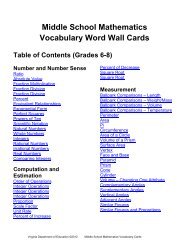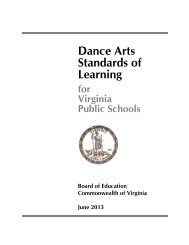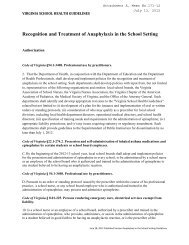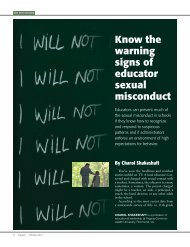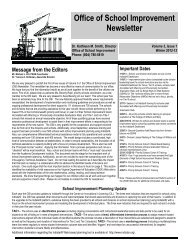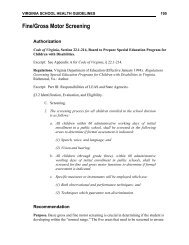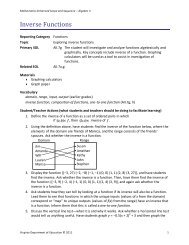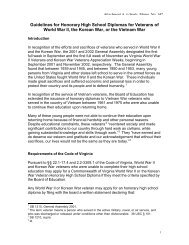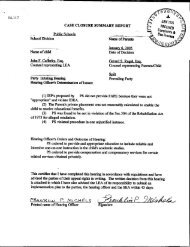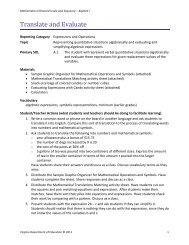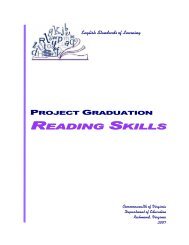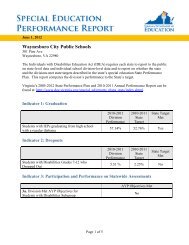What Makes Something Alive - Virginia Department of Education
What Makes Something Alive - Virginia Department of Education
What Makes Something Alive - Virginia Department of Education
You also want an ePaper? Increase the reach of your titles
YUMPU automatically turns print PDFs into web optimized ePapers that Google loves.
Topic 6: Session 6.1 – Introduction to Animal Adaptations<br />
Session Supplies:<br />
• Books about animals and adaptations. (There need to be enough books for each student to<br />
have a book. The books should be on the students‟ reading levels.)<br />
• Ducks Don‟t Get Wet, by A. Goldin, or another book about an animal that adapts to its<br />
environment<br />
• Student journals<br />
Session <strong>Virginia</strong> SOL<br />
Science English Mathematics History & Social Science<br />
2.2 a, b, c, e<br />
2.3 a, b, c<br />
2.6<br />
2.7 d, e<br />
2.12<br />
2.1 a, b, c, d, h, i, j, k<br />
2.5 a, b<br />
2.7 a<br />
2.8 c<br />
More information about birds can be found on the New Hampshire Fish and Game <strong>Department</strong> (NHFGD)<br />
Web site at http://www.wildnh.com/Kids/kids.htm, Birds! Birds! Birds! Vol. 3, Issue 2.<br />
Wild Times for Kids is published twice a year by the NHFGD. The magazine can be downloaded.<br />
Session 6.1 – Introduction to Animal Adaptations<br />
Teacher Questions & Notes<br />
-<strong>What</strong> do animals need to survive in a<br />
habitat?<br />
-How did the ducks survive?<br />
-Why is it important that a duck‟s<br />
wings do not get wet?<br />
Procedures<br />
Prior to the lesson, select sets <strong>of</strong> texts about animal adaptations<br />
leveled to meet the reading abilities <strong>of</strong> the individuals in the class.<br />
These may be stories from the basal texts, science texts, trade books,<br />
children’s newspapers, and magazines.<br />
1. Ask “<strong>What</strong> do animals need to survive in a habitat?” Have<br />
students brainstorm ideas, and write them on the board, chart<br />
paper, or on an overhead.<br />
2. After the brainstorming session, read Ducks Don‟t Get Wet, by<br />
A. Goldin, a book about how ducks are able to meet their needs<br />
in their habitat, or select another book that describes how an<br />
animal adapts to its environment.<br />
3. Discuss the information about ducks and introduce the term<br />
adaptation. Adaptations are what animals have or do to survive.<br />
-How do we adapt to our environment?<br />
-<strong>What</strong> do we do in winter to go outside<br />
when it is cold?<br />
-<strong>What</strong> do animals do when it gets<br />
colder?<br />
-<strong>What</strong> are some other ways animals<br />
survive?<br />
4. Have students think <strong>of</strong> ways that animals survive (adaptations).<br />
5. Brainstorm a list <strong>of</strong> adaptations and write them on the board,<br />
chart, or overhead (e.g., long teeth, hooves, big ears, feathers,<br />
wings, long legs, claws, hibernation, migration, camouflage,<br />
scents).<br />
176<br />
<strong>Virginia</strong> Animals and their Habitats<br />
Topic 6



